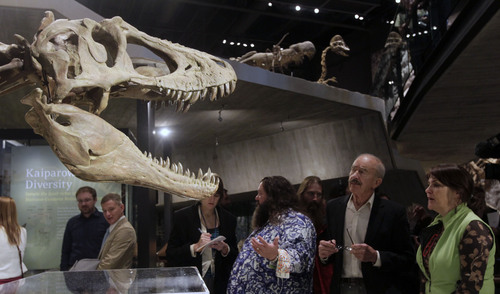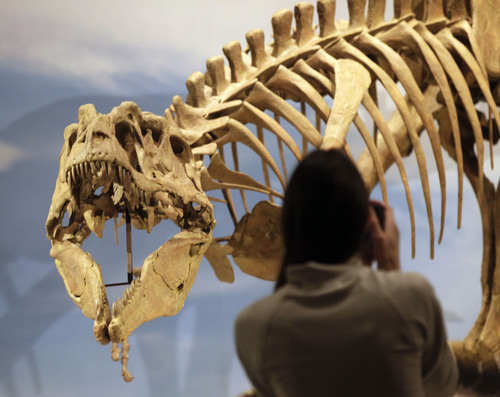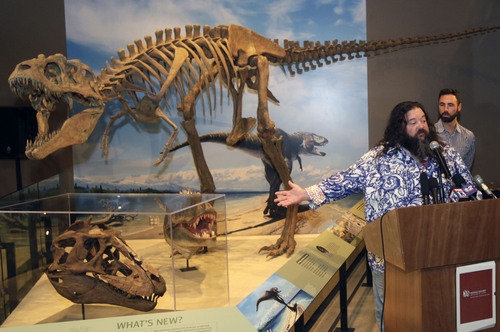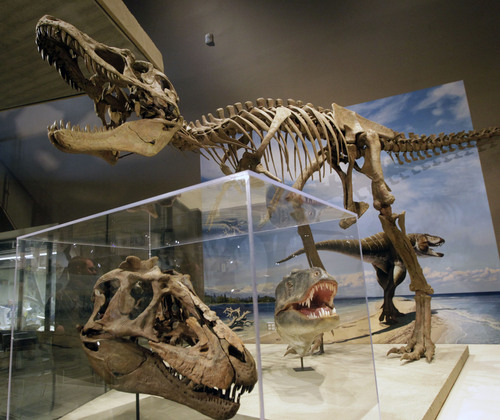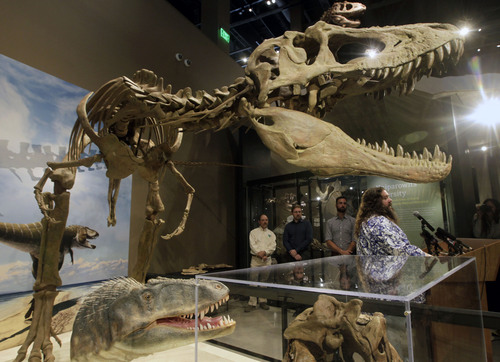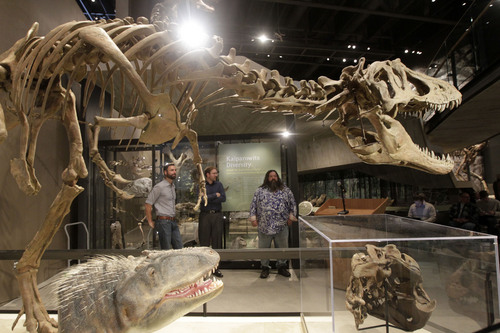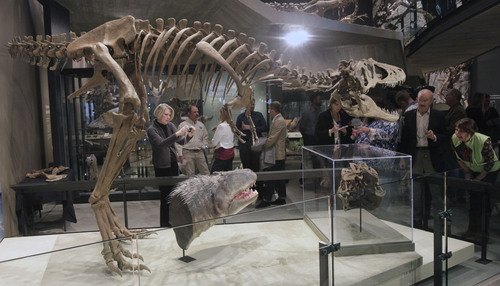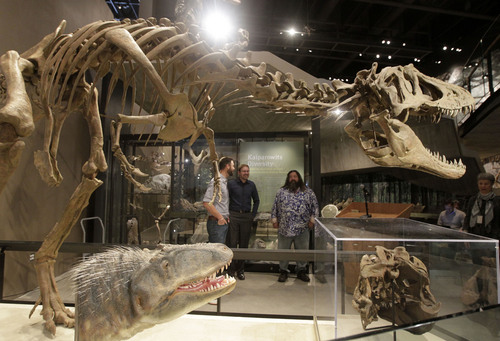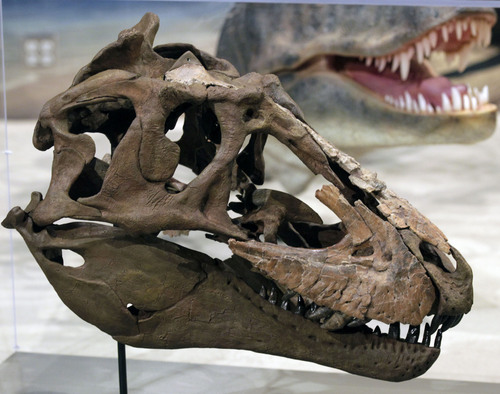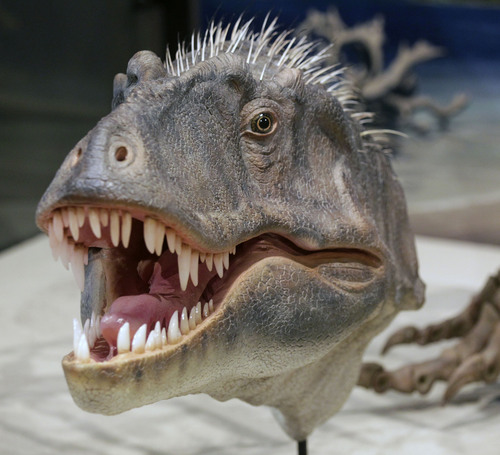This is an archived article that was published on sltrib.com in 2013, and information in the article may be outdated. It is provided only for personal research purposes and may not be reprinted.
Think the Tyrannosaurus rex was tough? Meet its great-uncle, whose name means "king of gore."
Paleontologists unveiled a newly discovered dinosaur species, Lythronax argestes, on Wednesday at the Natural History Museum of Utah. Now the oldest known tyrannosaur species, the rare fossil was unearthed in Grand Staircase-Escalante National Monument.
Though somewhat smaller than the T. rex would be, the 24-foot-long sharp-toothed creature weighed 2.75 tons and was the largest dinosaur alive at the time. Eighty million years ago, it walked on two powerful legs in a swampy, subtropical coastal setting and had a large head with a relatively narrow, short snout that made its skull stronger.
"That skull is designed for grabbing something, shaking it to death and tearing it apart," said Mark Loewen, a research associate at the museum, adjunct assistant professor at the University of Utah and the lead author of a study on the new species, published in the open-access scientific journal PLoS ONE.
Lythronax was probably covered in quills or feathers — an earlier relative found in China had 6-inch-long feathers down its back — and its eyes were placed at the wide back of the skull, which gave it an overlapping field of view perfect for spotting prey. So what did it eat?
"Whatever it wants," Loewen said. The skull is now on permanent display at the museum.
This specimen is thought to be a teenager, so, when fully grown, it may have been about 30 feet long, said co-author Randall Irmis, curator of paleontology at the museum. Though older examples of tyrannosaur relatives have been found, they are lighter and smaller, with larger arms.
Paleontologists had thought wide-skulled tyrannosaurids like Lythronax appeared 70 million years ago, but the discovery announced Wednesday shows it actually developed some 10 million years earlier.
"This revised the [evolutionary] tree. We completely changed the way we thought about tyrannosaur relatives," said co-author Joseph Sertich, curator of dinosaurs for the Denver Museum of Nature and Science. "It's shaken people up in the dinosaur world."
The name Lythronax, or "king of gore," is a reference to the dinosaur's large teeth and carnivorous appetite. Argestes refers to the poet Homer's southwest wind, so together they mean "king of gore of the Southwest."
A team of scientists from the Natural History Museum and the Grand Staircase discovered parts of the skull, hips, leg and tail during an excavation in 2010.
The initial discovery was made by Scott Richardson, a seasonal paleontological technician with the Bureau of Land Management who spends six months a year camping in the desert and searching for dinosaur bones. Richardson said Wednesday that he first noticed a leg bone in November 2009.
"I realized I had just walked through a skeleton," he said. "By the size of the bone, I knew this was a big guy."
It's not the first he's discovered — he also found the horned, triceratops-like Kosmoceratops richardsoni, which was named for him.
In fact, scientists have unearthed more than a dozen dinosaur species during the past 14 years at Grand Staircase, a 1.9 million-acre tract of high-desert terrain in south-central Utah. It was the last major area in the lower 48 states to be formally mapped by cartographers and is now the country's largest national monument.
"There are lots of places out there where you can't walk for more than a few minutes without finding scraps of … fossils," said Alan Titus, a paleontologist for Grand Staircase. "To me, it's like treasure hunting. I feel like I'm looking for lost Spanish gold, but it's more exciting."
Scientists are already working on about a dozen more new species that have yet to be announced. They also unveiled an example of another recently discovered tyrannosaur species, Teratophoneus Curriei, on Wednesday.
The Grand Staircase is rich with fossils because, over the millennia, floods rapidly deposited sediment throughout the area, protecting the fossils from decay, while tropical storms churned up the earth enough that they didn't stay buried too deep for discovery.
Other contributors to the paper were Philip Currie of the University of Alberta and Scott Sampson of the Denver Museum of Nature and Science.
Crews working in Grand Staircase also have unearthed herbivores such as duck-billed hadrosaurs, armored ankylosaurs and dome-headed pachycephalosaurs, as well as carnivores, including the "raptor-like" Talos and another large tyrannosaur, Teratophoneus.
The species proliferation developed when western North and Central America were part of a prehistoric island landmass called Laramidia. Eighty million to 95 million years ago, it was flooded by an interior sea that cut off species from each other, allowing them to evolve separately.
Tyrannosaurids originated in northern Laramidia and migrated down to the southern part of the continent, including what is now Utah. Though the sea eventually receded, the dinosaur species' differences were reinforced by variations in climate and food sources — including short-snouted tyrannosaurids like Lythronax in the south and longer-snouted cousins in the north.
Lythronax developed about 10 million years before T. rex, the youngest tyrannosaur on the evolutionary tree, but is nevertheless very similar, so scientists think there are more branches to fill in.
That means there are plenty of undiscovered carnivores out there waiting to be found.
Twitter: @lwhitehurst



